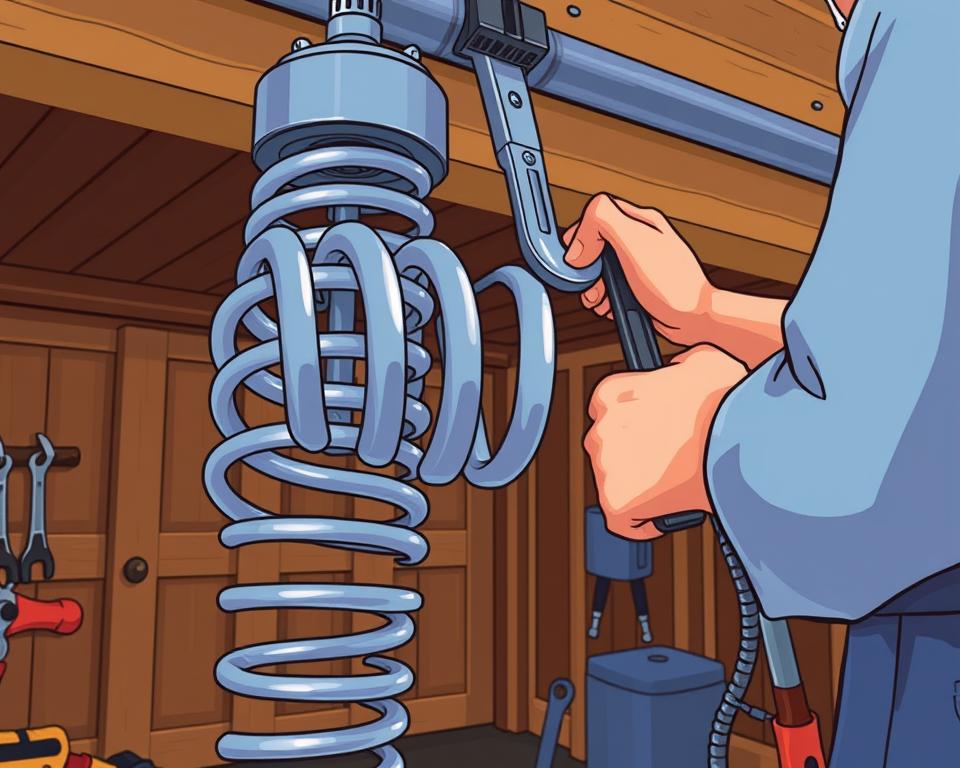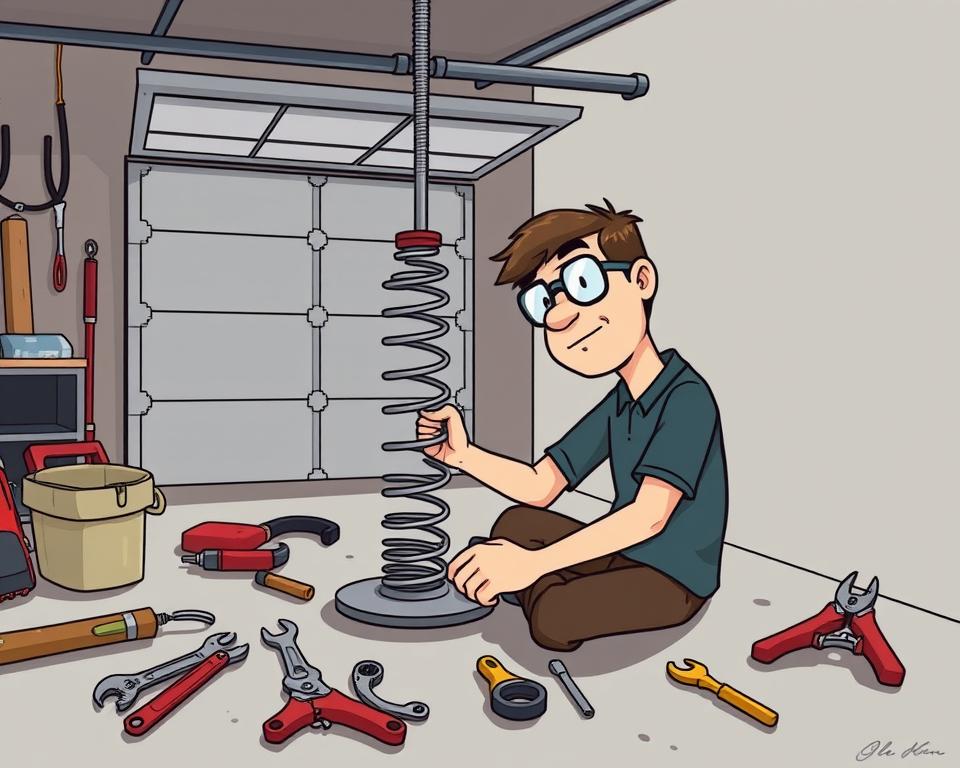Have you ever grappled with the thought of undertaking a DIY garage door spring replacement? The hefty weight of a standard Colorbond garage door, approximately 100kg, might fool you into thinking it’s a simple feat. But pause for a moment, what if the entire functioning of your garage door hinges on getting it right?
Garage door springs serve as the counterbalance to the door’s weight, playing a pivotal role in its smooth operation. With the substantial strain they endure, a broken garage door spring could render your door not just inoperable, but if mishandled, could lead to dire consequences, such as a burnt-out motor. The stakes for garage door spring repair are undeniably high, often pitting the potential cost savings of a DIY project against the grave risks involved.
Does the idea to how to change garage door springs open a Pandora’s box of potential hazards, or could it be a wallet-friendly venture for the skilled enthusiast? Let’s consult the professionals and unearth the facts behind these deceptively complex components.
For in-depth insight, explore the necessity of precision in replacing garage door torsion springs that keep the heart of Australian homes beating safely and efficiently.
Understanding the Role of Garage Door Springs

Garage door springs are integral components that greatly influence the functionality and safety of your garage door system. Understanding their operation, maintenance needs, and the risks associated with DIY attempts at replacing garage door springs is fundamental for any homeowner.
What Are Garage Door Springs and How Do They Function?
Garage door springs are designed to balance the door’s weight, making it easier to open and close smoothly. There are mainly two types of springs used: torsion springs and extension springs. Torsion springs are mounted above the garage door and help in lifting the door by uncoiling and storing mechanical energy. On the other hand, extension springs, typically found on either side of the door, extend and contract as the door operates. These components are crucial as they manage the heavy lifting, making the door manageable for automatic openers and manual operation.
The Importance of Proper Spring Tension for Door Balance
The right tension in garage door springs is vital for achieving proper balance and ensuring the door operates smoothly without tilting or becoming unevenly worn. An improperly balanced door can lead to premature wear and tear on the door opener and other structural components. Additionally, it can pose a safety risk, causing the door to fail unexpectedly. Therefore, maintaining the correct tension is crucial, which can often involve garage door spring maintenance and adjustments by professionals.
Lifespan and Maintenance: Extending the Life of Your Springs
Garage door springs are not designed to last forever. With an average lifespan ranging from 7 to 10 years, the actual duration can greatly vary depending on the usage, type of spring, and regular maintenance. Regular lubrication, proper installation, and periodic checks are essential in extending the lifespan of these springs. It is crucial to fix broken garage door springs as soon as issues are noticed. Symptoms like noises during operation, visible damage, or challenges in opening or closing the door are common indicators that the springs might need professional attention or possible replacement.
Given the complexities and the inherent dangers involved in handling high-tension springs, professional vs DIY garage door spring replacement often leans heavily towards hiring experts. Professionals bring the necessary tools, experience, and understanding of safety protocols required to manage and replace these components safely. DIY attempts not only risk personal injury but may also lead to improper installation, which could necessitate further repairs or even replacement sooner than expected.
Maintaining and servicing your garage door springs periodically enhances their reliability and safety. Opting for professional services ensures that all aspects of garage door spring safety are adequately addressed, providing peace of mind and extending the operational efficacy of your garage door.
Should I Replace Garage Door Spring Myself?
Deciding whether to undertake DIY garage door spring replacement requires a thoughtful assessment of the risks involved, particularly within the Australian context. Garage doors are heavy, often twice as heavy when springs break, and navigating the replacement can be treacherous. The variety of springs, such as torsion springs with their high energy storage posing greater risk, and extension springs, demands distinct approaches and safety considerations. Given the various types, including open-looped, double-looped, and clipped-end for extension springs, and standard torsion springs common in residential setups, understanding the precise part you need is critical.
The complexities of garage door spring installation are not to be underestimated. Australian homeowners who consider themselves proficient in home repairs might contemplate a DIY approach, especially when faced with the potential costs for professional services ranging from $150 to $350. However, with over 30,000 injuries annually related to garage door accidents, the question of a professional vs DIY garage door spring replacement leans heavily towards seeking expert assistance. The high tension within these springs—designed to counterbalance the weight of your door—could unleash hazardous forces if mishandled.
Professional installers possess not only the tools and expertise but also the necessary experience to select the right spring type—be it open-looped, double-looped, clipped-end, standard torsion, or others—and apply the accurate tension needed for your door’s balance and safety. With torsion springs known for dangerous energy retention, professional handling becomes even more justified to prevent severe accidents. Although extension springs provide a more manageable task, they are color-coded by weight capacity, and an incorrectly matched spring can lead to door malfunction or injury. Regardless of the choice, whether DIY or professional, the imperative lies in opting for a reliable solution that prioritizes safety and durability over short-term savings.
FAQ
Q: Should I replace a garage door spring myself in Australia?
A: No, it is strongly advised not to attempt a DIY garage door spring replacement due to the high level of risk and the expertise required. Professional technicians have the necessary tools and knowledge to safely perform garage door spring repairs and replacements.
Q: What are garage door springs and how do they function?
A: Garage door springs are crucial components that enable the opening and closing of the garage door by counterbalancing its weight. They operate under high tension to manage the door’s mass, allowing it to move smoothly and with less strain on the opener.
Q: Why is proper spring tension important for garage door balance?
A: Proper spring tension ensures that the garage door remains balanced and operates correctly. Adequate tension prevents the door from tilting or becoming unevenly worn, which can lead to damage or increased wear on the garage door opener.
Q: How can I extend the life of garage door springs?
A: The life of garage door springs can be extended by performing regular maintenance such as lubrication with silicone-based oils, seasonal balance checks, visual inspections, and ensuring correct tension. Quality springs and consistent upkeep can result in a longer service life.
Q: Is the DIY garage door spring replacement more cost-effective than professional installation?
A: While DIY might seem like a cost-saving option, the potential for mistakes, injuries, and further damage to your garage door system can lead to more expenses. Hiring a professional for garage door spring installation ensures a safe and efficient job, which can ultimately be more economical due to accurate work and warranty offers.
Q: How do I know if my garage door springs need replacing?
A: Tell-tale signs that your garage door springs may need replacing include a loud bang (indicating a break), difficulty in opening or closing the door, the garage door sagging on one side, or visible wear and rust on the springs. Regular servicing will help identify any issues before they become serious.
Q: What are the risks of replacing garage door springs yourself?
A: DIY replacement of garage door springs carries significant risks due to the high tension under which the springs operate. Improper handling can lead to severe injuries, including lacerations, fractures, and even life-threatening accidents. Always seek professional assistance for this task.
Q: Can incorrect spring tension affect the lifespan of a garage door opener?
A: Yes, incorrect spring tension can cause a garage door to become unbalanced, leading to the opener working harder than necessary, which can strip gears, wear out the motor, and significantly reduce the lifespan of the garage door opener.
Source Links
- Garage Door Spring Replacement Cost – Get The Facts
- What Is The Cost To Replace A Garage Door Spring?
- How to replace a garage door spring – the cost of this repair and whether to DIY
- The Risks of Replacing Broken Garage Door Springs Yourself
- Stop What You Are Doing & Read This Guide To Replace Your Garage Door Spring
- Garage Door Spring Replacement | Automatic Garage Solutions
- Garage Door Spring Repair: Should I Replace On My Own Or Not? | Overhead Door Company of Tampa Bay™
- 6 Things to Know Before You Replace a Garage Door Spring

